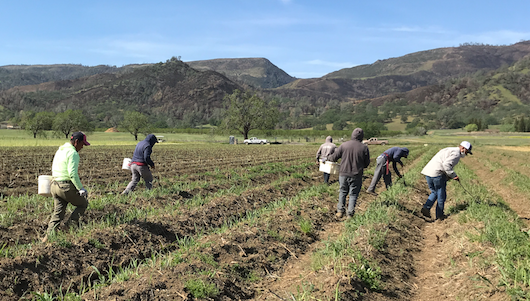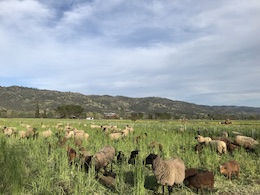
Asparagus crew —
Why did the sheep cross the road? To get to the other side!
Specifically, last week this year’s lambs and their mothers crossed from the fields next to lambing barn to our fields on the east side of Highway 16 to eat down the cover crops! The cover crops are at the right maturity to incorporate into the fields, and we need to get those fields ready for our summer plantings. To do that, we could use a tractor to mow down the cover crops or the sheep to munch them down. Both methods have their benefits and drawbacks. The sheep do great work, but they go through the field more slowly than the tractors, and there’s more left in the field after they head out, so we have to go back in to do some cleanup work. But when we can, we like to use the sheep. Unlike a tractor, they cut the plants and break down the biomass a bit via digestion making the nutrients more quickly available for the microbes and plants that will soon be growing there. The trick is making sure they have the right amount of space – not too much or too little. Putting many sheep on a relatively small section of land helps keep them from being selective with what they eat and leaving some plants behind. They’ve been moving through 1.5 acre blocks in about four days. See the photos for proof. And we also have to keep timing in mind – organic and food safety regulations prevent us from harvesting produce from fields that have been grazed for certain time periods.


Day 1 – Before the sheep enter Day 2


Day 3 Day 4 – After the sheep leave
But the sheep also might have crossed the road to get a better look at the asparagus! We’ve got two fields and one is not too far from their new home. And asparagus is worth crossing the road for; in addition to being delicious, it’s a very cool plant to watch grow. Asparagus is a perennial vegetable that’s a member of the Lilly family. You can plant it from seed, or by transplanting the crowns (roots). We started the seeds in the greenhouse, then transplanted them into the field and then waited until the third year to harvest. Once established, we’ll keep these crowns in the ground for about 12 years (they can produce for longer, but the production declines and the spear size decreases). The crowns stay in the soil the entire time and the part we’re harvesting are the spears as they emerge from the soil, like something out of an alien horror movie.

Asparagus growing in the field
And the spears are definitely emerging! They can grow fast (3 to 6 inches per day!), especially with last week’s warmer weather, so there’s a daily harvest where the team goes up and down the rows with special asparagus knives that cut just below the soil. They cut out the spears that are a good height and width and leave the shorter spears to grow more. If there are any that are too skinny, or too oddly shaped to be easily bunched, they cut them and leave them in the field, preventing the plant from wasting more energy on those spears, and saving our packing crew the trouble of sorting them out. The asparagus is brought back to our packing crew and are sorted, bunched, and trimmed into the neat, tidy bunches you’re used to seeing. It’s a lot of work, thus why asparagus can be so pricy, but we think it’s worth it.
In a few weeks, we’ll stop harvesting and the unharvested shoots will turn into tall, fern-like leaves for the summer which take in energy to store as food for the crowns. Then the ferns will die back, be mowed in, and after a brief period of empty-looking fields, the cycle will start again. But we’re not at that point yet – still very much in harvest mode.
Elaine Swiedler, CSA Manager
